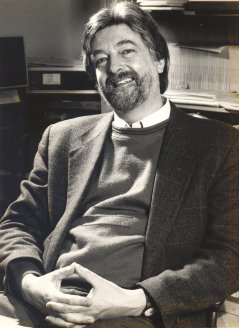
1982 – 1992; legacies reconsidered
The appointment of Prof. Alexander Zehnder increased the focus on anaerobic and environmental microbiology. During his PhD work he isolated the acetate-utilizing, methane-forming Methanothrix soehngenii; an important discovery as, in most environments, the formation of methane is the final step in the decomposition of biomass. This research was renewed by Mike Jetten, who obtained a cum laude PhD in 1989 and provided insight into the enzymatic and molecular details of this acetoclastic methanogenesis. Prof. Jetten now holds the Chair of Microbiology in Nijmegen.
Microbial phosphate removal, which had started in the sixties with the pioneering work of Dr Mia Deinema, was intensely studied during this period. A new research line was initiated by Dr Alfons Stams who primarily focussed on syntrophic conversions involving bacteria and archaea in anaerobic systems. He later obtained a personal chair and led the Microbial Physiology research.
Biofilm formation
New insights into biofilm formation were pioneered by examining the biophysical interactions of bacteria and solid substrates by PhD fellows Huub Rijnaarts and Mark van Loosdrecht, who later became professors in Wageningen and Delft respectively. Modern insight into bacterial biofilms, problems with biofouling, and the use of microbial consortia in wastewater treatment are some of the applications that have resulted from their work.
Degrading chlorinate compounds
In this period, the Laboratory of Microbiology initiated the development of bacterial cultures that could degrade toxic, chlorinated compounds. The research improved our understanding of bacterial adaptation in Pseudomonads as pioneered by Jan Roelof van der Meer, cum laude PhD 1995, who later became professor at EPFL Lausanne. It also led to the isolation of the first dehalogenating anaerobe able to remove toxic chlorinated compounds from chemical-industry wastewater. The organism, Dehalobacter restrictus, isolated by Dr Gosse Schraa and PhD fellow Christof Holliger (later to become professor at the University of Lausanne) from the river Rhine, is capable of using these compounds for its growth.
